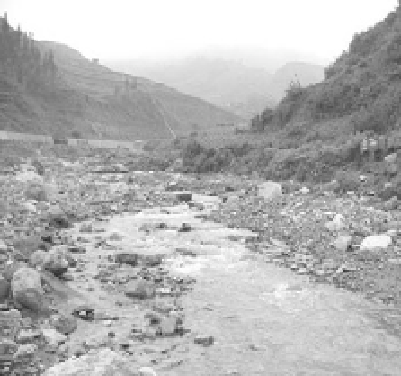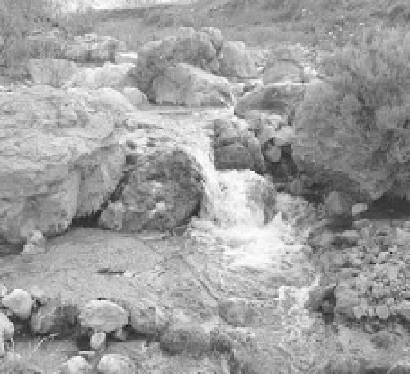Environmental Engineering Reference
In-Depth Information
flow hazards and restoration and improvement of ecology with an artificial step-pool system (Yu et al.,
2010). Step-pool systems are effective in dissipating flow energy and stabilizing riverbeds (Wilcox et al.,
2006). This is achieved by increasing flow resistance (Aberle and Smart, 2003). In some instances,
step-pool systems comprise more than 90% of the resistance, with grain resistance and channel form
drag making up less than 10% of the total resistance (Curran and Wohl, 2003). A step-pool system on
mountain streams is ecologically sound. Some studies have found that the richness and abundance of
macro-invertebrates species are much higher in streams with step-pool systems than other streams
without step-pools (Cereghino et al., 2001; Wang et al., 2009). Development of a step-pool system has
become an important strategy for incision control and ecological restoration. A restoration project in
Kleinschmidt Creek, Montana, USA, took steps to restore the aquatic habitat of trout and salmon
(http://fwp.mt.gov/habitat/). Recent research has examined the design criteria and effects on ecology of
step-pool system (Lenzi, 2002; Lenzi and Comiti, 2003; Todd and Mike, 2003; Weichert, 2005; Weichert
et al., 2009). Field experiments found that morphological alterations, even if slight, may affect biological
diversity and the presence of some specific taxa (Bona et al., 2008). Hence, artificial step-pools seem to
provide a good trade-off between the need to limit channel incision whilst maintaining the functionality
of aquatic ecosystems (Comiti et al., 2009).
The experiment was conducted in June 2006 on a 260 m long reach of the Diaoga River. The experimental
reach is located at the middle of the river, controlling a drainage area of about 18 km
P
2
P
. Design and
construction of 24 artificial steps were based on the results of field investigations and flume experiments
on step-pool systems. The artificial steps mimic the structure configuration and planform feature of
natural steps developed in ecologically-sound mountain streams. The distance between these steps is
about 5-12 m and the height of each is about 1 m. Large stones of diameter ranging from 0.2 to 1.5 m
were laid overlapping with each other to act as a framework tightly interlocking the step structure with
considerable stability. The experimental reach of the river and the constructed step-pool system are
shown in Fig. 11.53.
(a) (b)
Fig. 11.53
(a) Experimental reach on the Diaoga River (May 2006); (b) Constructed step-pool system on the river
bed (March 2007) (See color figure at the end of this topic)
The topography of the stream bed (the longitudinal profile and cross sections) and aquatic habitat
environment (water surface area, substrate, flow velocity, and water depth) were monitored before and
after the construction of the artificial step-pool system. In total, 46 cross sections were placed upstream of



Search WWH ::

Custom Search